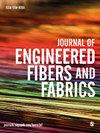纬纱类型和弹性纱线穿线对弹性经编织物性能的影响。第二部分:热舒适性能
IF 2.3
4区 工程技术
Q1 MATERIALS SCIENCE, TEXTILES
引用次数: 1
摘要
本研究的目的是确定医用弹性经编织物的性能。采用不同的纬纱材料,改变弹性体纱线的穿线顺序,对样品进行编织。弹性经编织物的尺寸和弹性性能的详细结果已在本系列的第一部分中报道。研究了纬纱材质和弹性体纱线的穿线顺序对热舒适性的影响。已经发现,横向纬纱的类型和线密度以及织物结构中弹性体纱的数量显著影响所开发的弹性经编织物的热舒适性和透气性特性。根据结果,使用聚酯纱线作为纬纱并减少弹性体纱线的数量导致透气性增加。此外,织物的导热特性随着结构中弹性体纱线数量的增加而增加。从结果中可以看出,样品的抗水蒸气系数适用于这些织物在医疗产品中的使用。本文章由计算机程序翻译,如有差异,请以英文原文为准。
The effect of weft yarn type and elastomer yarn threading on the properties of elastic warp knitted fabrics. Part II: Thermal comfort properties
The aim of this study is to determine the performance properties of elastic warp-knitted fabrics used for medical purposes. The samples were knitted using different weft yarn material and changing the threading order of elastomer yarn. The detailed results of the dimensional and elasticity performance of elastic warp-knitted fabrics had been reported in Part I of this series. In this part, the effects of weft yarn material and the threading order of elastomer yarn on the thermal comfort characteristics were investigated. It has been seen that the type and linear density of the transverse weft yarns and the number of elastomer yarns in the fabric structure affected significantly the thermal comfort and permeability characteristics of the developed elastic warp-knitted fabrics. According to the results, using polyester yarns as weft and reducing the number of elastomer yarns led to an increase in air permeability. Additionally, the thermal conductivity characteristics of the fabrics increased as the number of elastomer yarns in the structure increased. It has been seen that from the results, the water vapour resistance coefficient of the samples is appropriate for the usage of these fabrics in medical products.
求助全文
通过发布文献求助,成功后即可免费获取论文全文。
去求助
来源期刊

Journal of Engineered Fibers and Fabrics
工程技术-材料科学:纺织
CiteScore
5.00
自引率
6.90%
发文量
41
审稿时长
4 months
期刊介绍:
Journal of Engineered Fibers and Fabrics is a peer-reviewed, open access journal which aims to facilitate the rapid and wide dissemination of research in the engineering of textiles, clothing and fiber based structures.
 求助内容:
求助内容: 应助结果提醒方式:
应助结果提醒方式:


